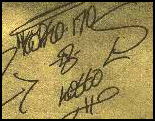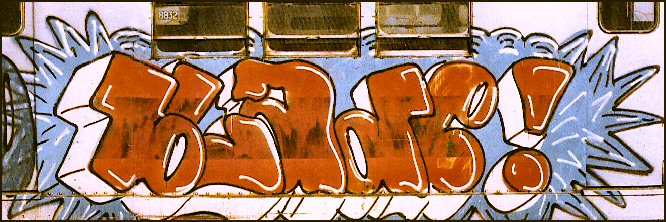|
Some are born with it. Others discover it along the way. There are others who may never find it. For me, it was a skewed road that took me through several walks of life; hobby to hobby, major to major, job to job. In the early 90ís, I finally became aware of my passion. A story-teller. A dream-maker. One who mixes words with motion.
Now that I have discovered my lot-in-life, I wanted to take a look back. A look back in an attempt to shed some light on how I arrived at this realization and I invite you along for the ride. So, grab a chair and strap yourself in. We're taking a time-slide back to the past. From its earliest beginnings in ancient Rome to the subway tunnels of New York City (circa 1970's). Allow me to introduce to you the surreal urban sub-culture known as ... graffiti.

The word derives from the Latin word graffito meaning a scribbling or etching on a flat surface. In ancient Rome, critical commentaries were written on public walls so others may become aware of their protests. Flash forward 2000 years ... where the concept of graffiti has now taken on (depending on the public POV) several different interpretations.
First, let me tell you what graffiti is not.
- It's not the written language of gang-bangers.
- It's not a swastika painted on someone's house.
- It's not one of the four elements of Hip Hop.
- It's NOT anything you see in a MTV, BET, or VH-1 video.
For a lengthy explanation of the term, read Susan Phillips' rendering over at Art Crimes.
There's an abundance of web sites that tackle the subject of what graffiti is and what it is not. Psychologists, criminologists, and college professors have lectured, written reports, and done surveys but first-hand knowledge is something they missed out on. I did my reports and surveys at the Bronx Institute of Higher Learning a.k.a. The Two's-n-Five's of the IRT.
The infamous I.R.T. (Interborough Rapid Transit)

For a complete map of the NYC subway system: www.nycsubway.org

Twentieth century graffiti evolved during the waning days of WW II. GI's across Europe were finding the repetitive markings of a mysterious individual who wrote Kilroy was here wherever he had been. Kilroy's "tag" became synonymous with the "V" (victory) symbol and soon found its way into the annals of American folklore.
The 50's ushered in a new form of graffiti appropriately coined "shithouse poetry" or latrinalia; writings of bathroom walls. During this time, the advent of urban gangs turned to graffiti to help identify themselves as well as mark their territories. Modern-day graffiti, the one most are familiar with, did not take root until the late 60's/early 70's. This "Nu Yawk Style Graffiti" evolved from a simplistic origin of young kids scribbling their names (or aliases) throughout the five boroughs into a global phenomena that has attained a genuine stature in the art world of today.
 On the right: Photo of my tag from 1978.... On the right: Photo of my tag from 1978....

Back-in-the-day or old school are contemporary terms used by graffiti writers when describing the golden era of "Nu Yawk Style Graffiti" (mid-70's through early-80's). I've been asked by many people over the years, "What was it like back then?" To be honest, it was like any other time period in one's life, not realizing how different or special it was - until it was over.
I was just a kid in the 70's. Growing up along Bronx Blvd., my friends and I found entertainment through various means. The Bronx Park was an immense playground where we engaged in sports, snowball wars, man-hunt, and scully. We also discovered a new pastime called "bombing the subway lines." The word bombing is one of those graffiti words that simply means: to cover an area (wall, subway car, parkhouse, etc.) with the writer's pseudonym in either ink or paint.
For an extensive listing of graffiti terms: www.graffiti.org
My first encounters with early writings occurred in the Bronx Park (circa 1972). Some of the names I recall were "Kool Earl 219," "Dr. J," "Ajax," "Santana," and "Super Kool 223." At first, I thought you were suppose to copy the names you saw and write them elsewhere. (Cut me some slack - I was only seven-years-old at the time!). Another graffiti writer then pointed out to me that I needed to create my own tag. Note: "Teako~170" wasn't my first tag. I went through multiple aliases before adopting that name in 1974-75. Earlier tags included: "Terry-1" and "Kool Kitten 219" (silly, I admit but not half as bad as my writing partner's early tag which, out of respect to him, I will not disclose).
And so it began. First with watercolor markers, then with "Marks-A-Lot" brand markers & Pilots. Later, we started making our own markers (mops, mini's & uni's) and added a blend of different inks. Black was the most widely used as blue and red would easily fade but also popular were white and purple (similar to the type used in grocery stores for stamping products). Once we discovered spray paint, graffiti took on a whole new concept.
But before I go on, let's take a step back. What was the reasoning behind writing your name or tag all over creation? Wasn't this a form of vandalism? Wasn't this an illegal activity? How can one claim this destructive act as a form of art?

Art can be either static or visual; example, a painting or sculpted work. Art can also be a literary or musical piece such as film, theater, or poetry. To be "art," the product does not have to be pleasing to the eye or cause a satisfactory aesthetic experience. In other words, it doesn't have to be good, beautiful, or worth value. An artist uses their creation as a medium to express or communicate past experiences with present ideas, attitudes, and beliefs. So how does graffiti fit into this mold?
While I can only speak for myself, graffiti was a way of expressing one's existence: "Hey, look world. Here I am!" Everyone, to a degree, desires to be acknowledged by others - be it family, friend, or foe. Companies have logos. Nations have flags. Human beings are a social animal. We all require some form of recognition from our fellow man.
Back to the park.... A tag here. A throw-up there. Soon, larger and more complex pieces (short for masterpiece) emerged from this crude activity and the entire area was covered in a frenzy of cryptic letters that each writer designed as his (or her) individual style. But the park wasn't enough. We wanted the whole city to know who we were. That's why the use of the subway system came into play and how this art form evolved.
Circa 1975: An early BLADE piece on the Lexington Avenue Line


One of the many writers' crews, The Magnificent Team or TMT, circa 1977
Note: Majority of images are from Subway Art (Cooper & Chalfant).
(Images used with permission by Martha Cooper and should not be reproduced without author's consent.)
Using the subway lines as a moving canvas, graffiti writers not only expanded the realms of their identities but their own creativity levels as well. The simple tags and throw-up pieces of the early 70's transformed into a collage of advanced productions in style, color, and proportion.
The first Burners....

...and Top-to-Bottom pieces became the next step for the graffiti writer.

Competition soon brought about a unique style called the Wild Style....

Hey! Don't stop now....
This may be the end of this page but continue here for part 2!
|

